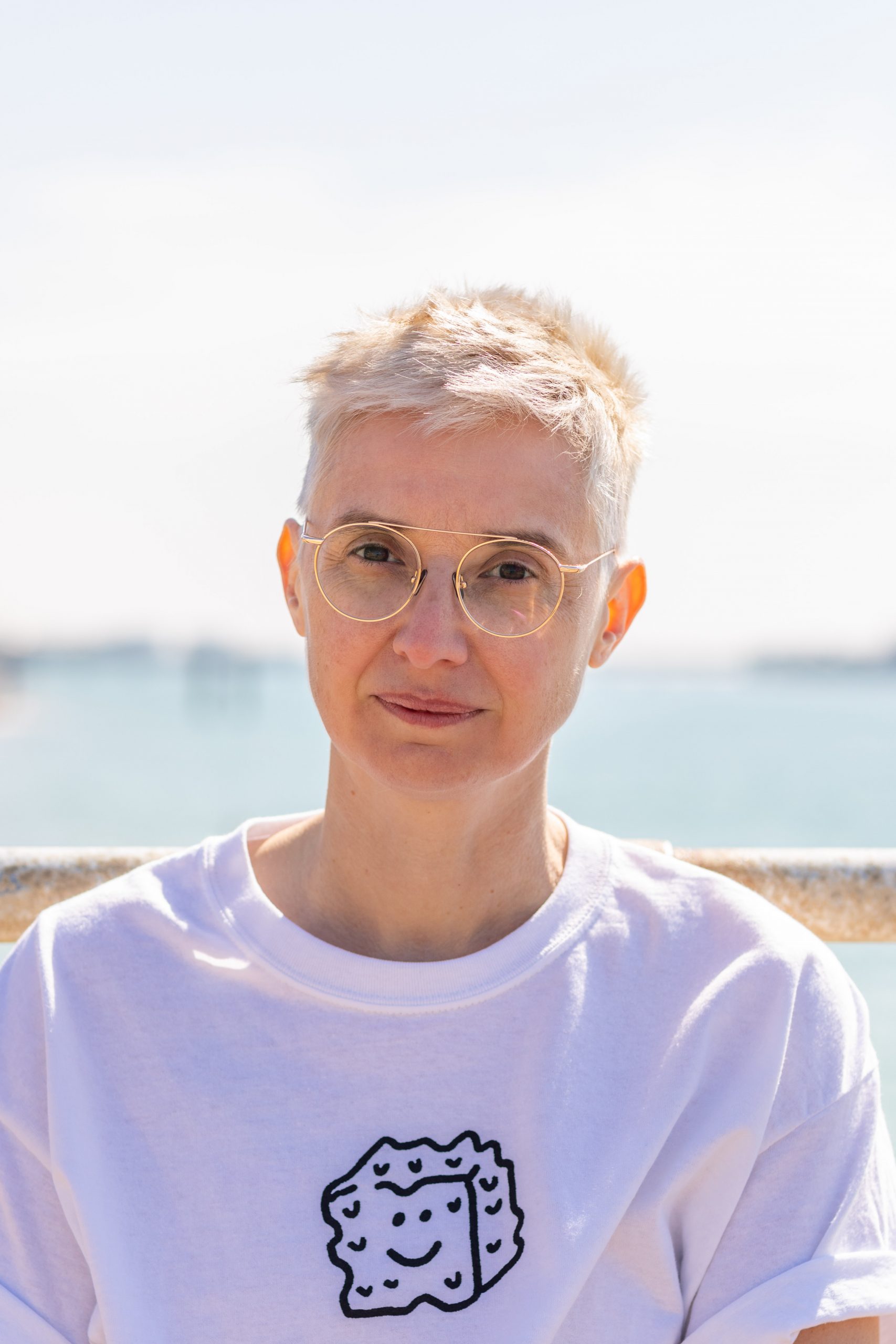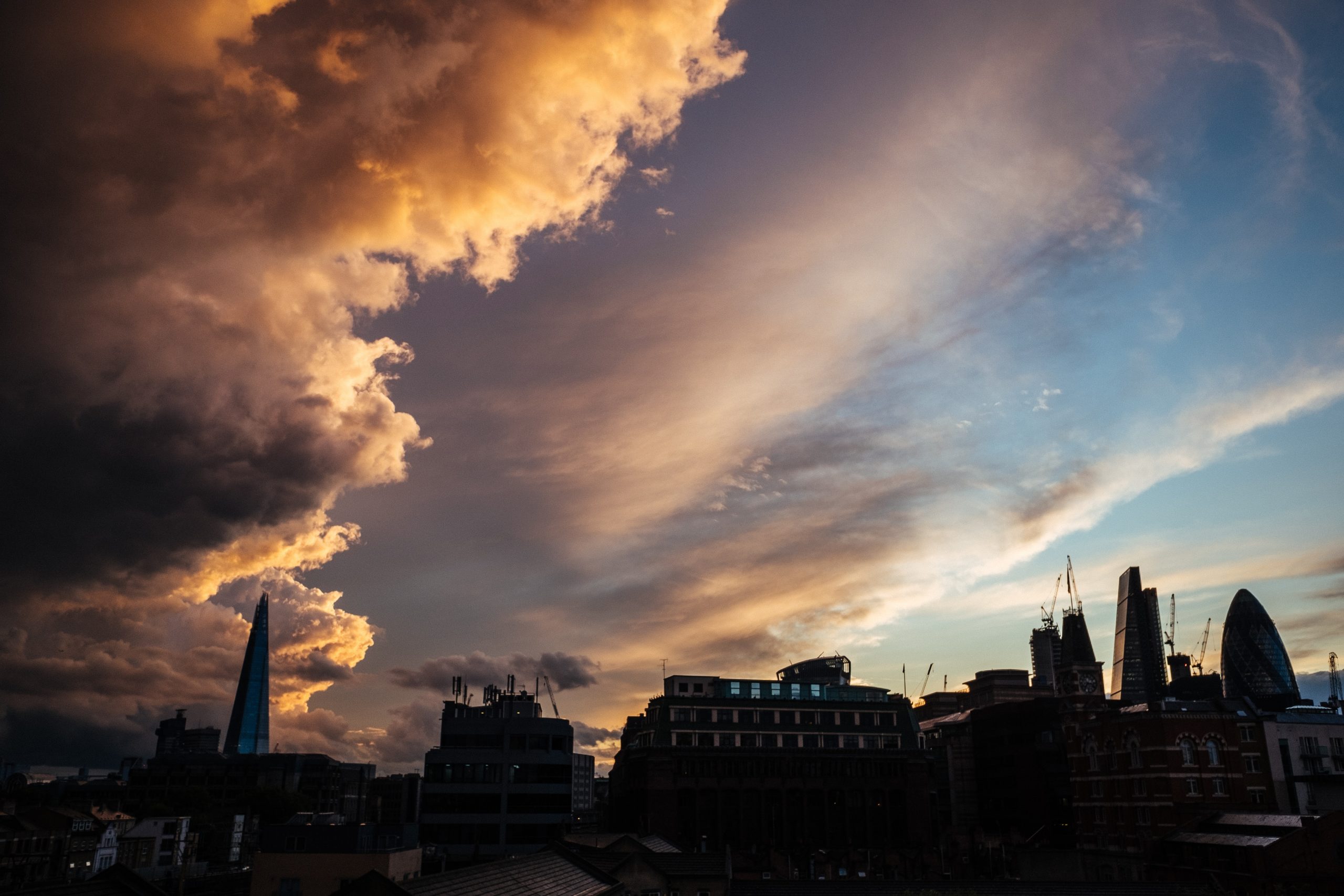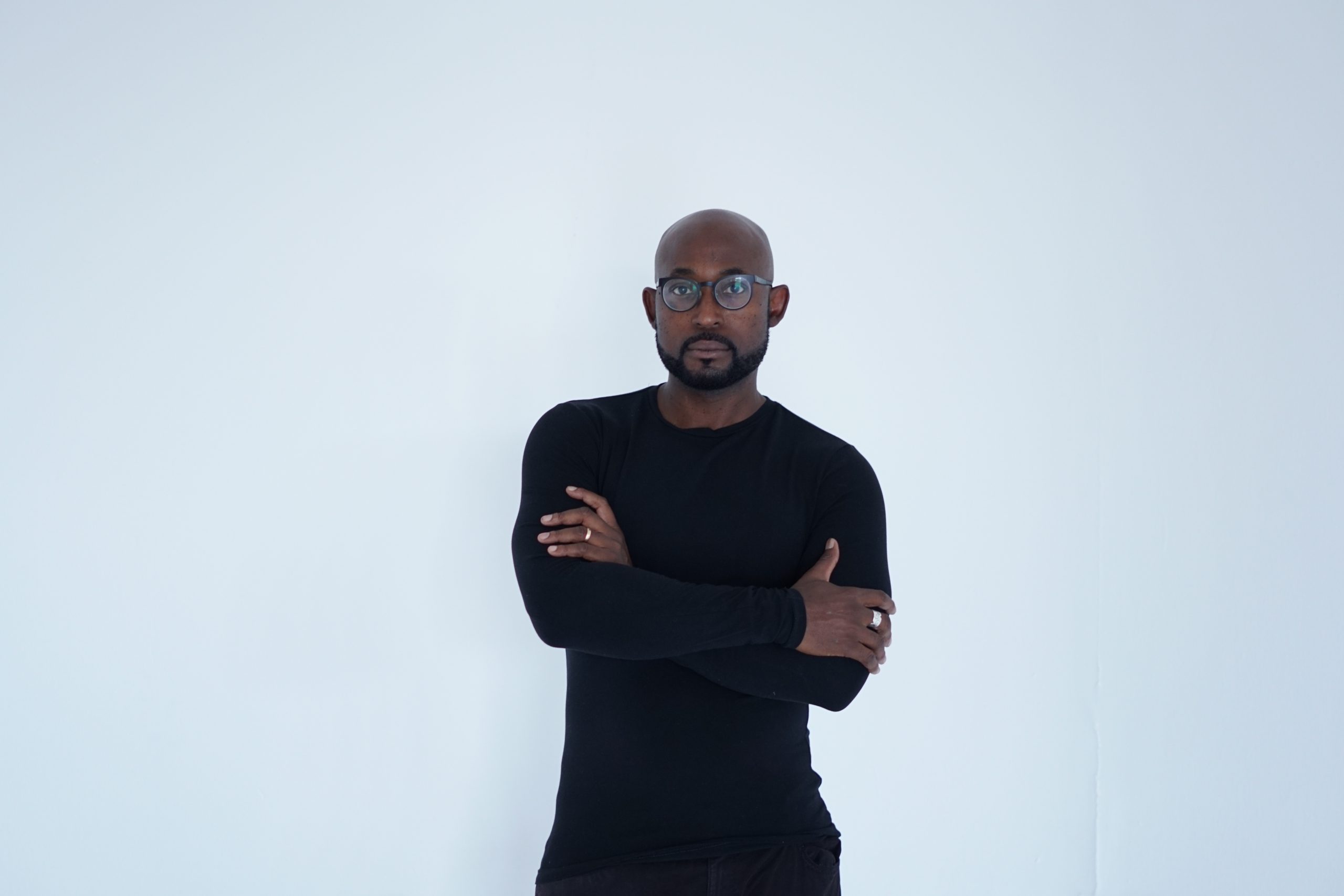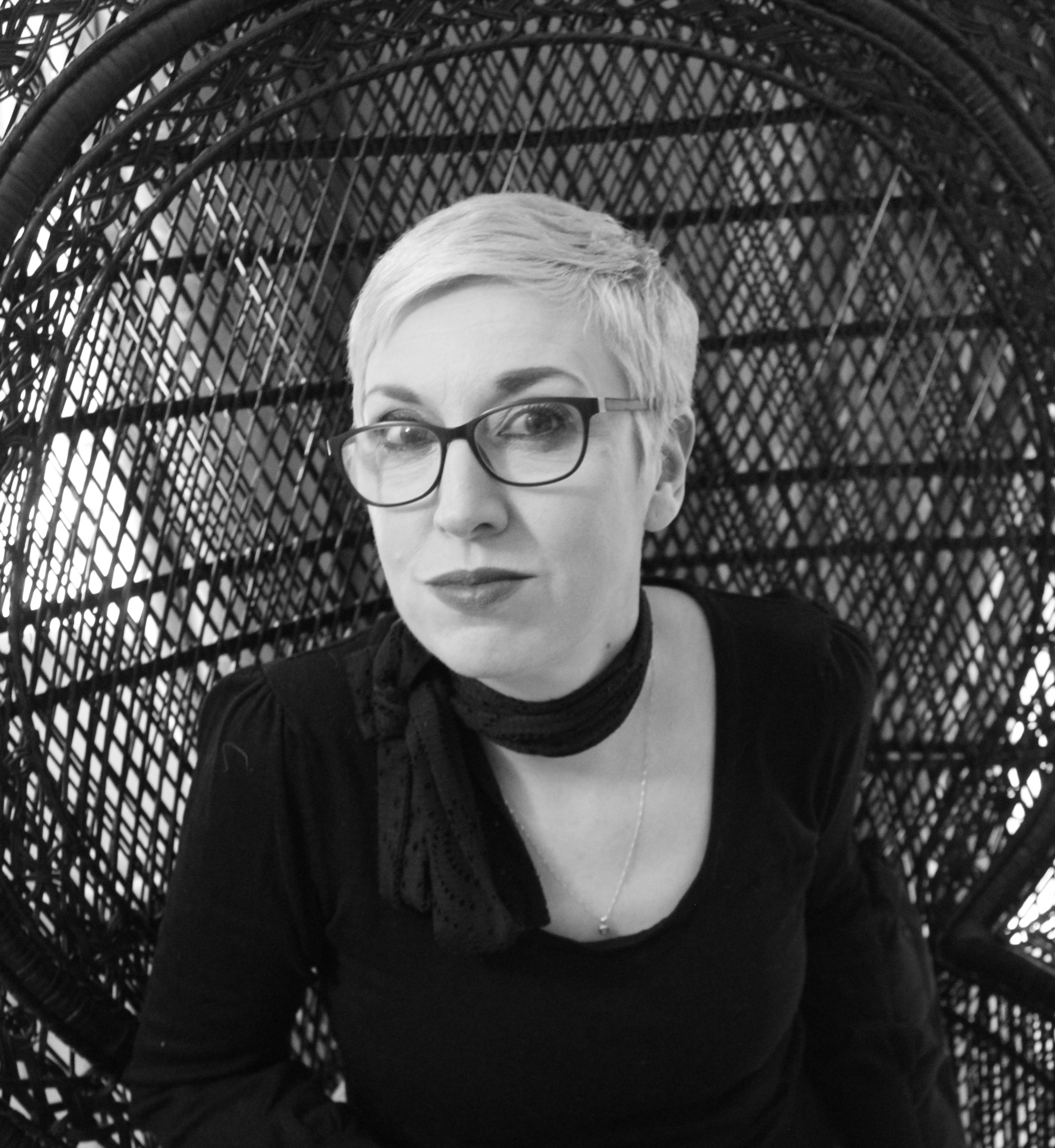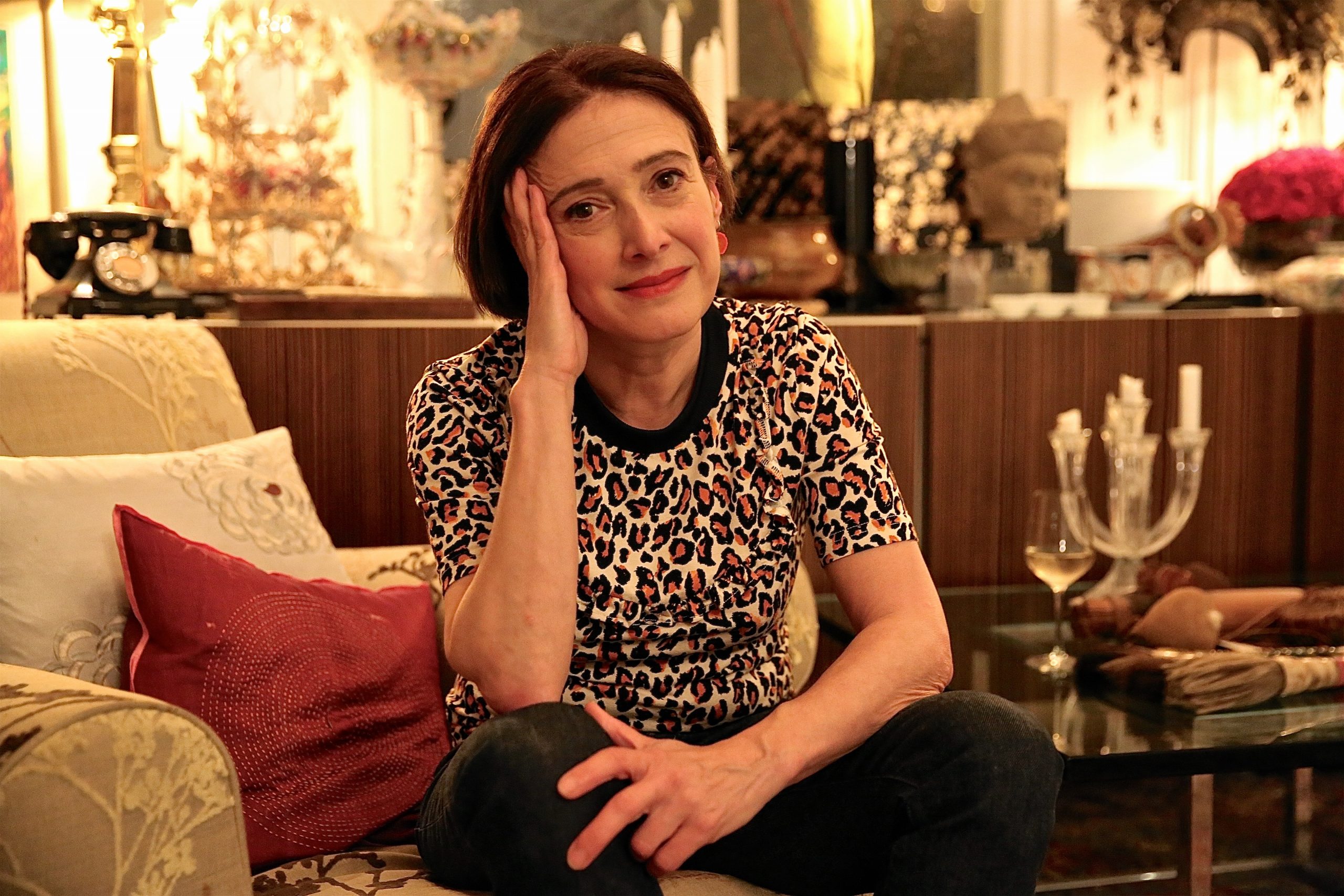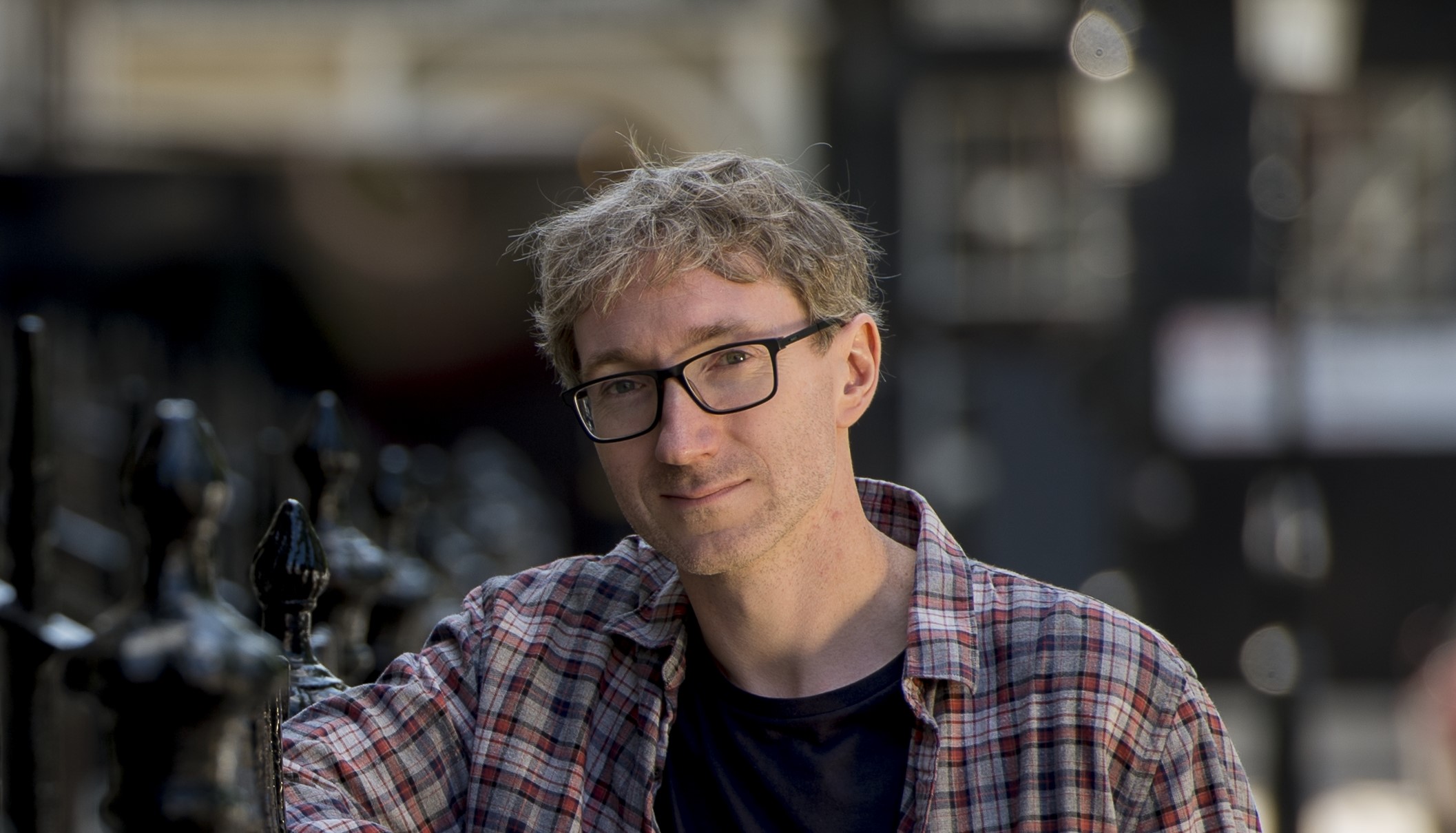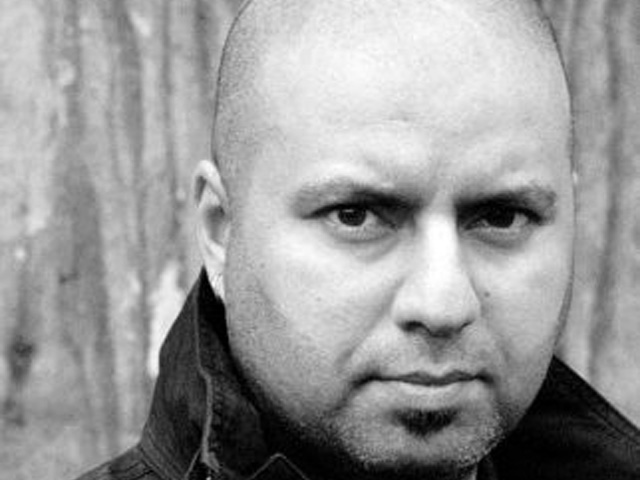‘A transformational chase to confound all predators’: An interview with Fran Lock by Matt Bates
In this in-depth interview Fran Lock discusses queer mourning, radical feminism, therianthropy, and why she likes her poems to misbehave.
_
MB: The hyena is an animal which elicits both disgust and distrust, perhaps even a certain queerness. It seems a symbolic choice for your collection. Can you tell us more about your Hyena! poems?
FL: I’m glad you mentioned queerness in relation to Hyena! Across all of the books in which Hyena! appears – and there are now three of them – the hyena is an avatar for particular kinds of emotional experience or thought, experiences that I have come to identify as queer. Hyenas in folklore are persistently figured as fluctuant and threatening; they have outlandish magical properties – their shadow strikes you dumb, there is a stone in their eye that grants the gift of prophesy –, they are harbingers of death and destruction. The hyenas of legend shift between categories of species and sex: neither animal or man, cat or dog, male or female. Queerness is also a mode of being that is imperfectly held within language; that cuts across and partakes of multiple categories of vexed belonging. This otherness is something I connect to my sexuality, but more so to cultural and class identity; to a feeling of being simultaneously both and neither. The experience of queerness is the experience of finding no perfect expression of solidarity, no true home within any single territory or lexical field.
The first Hyena! poem I wrote (‘Wild Talents’) was provoked by a sudden and unsettling experience of loss. It takes its title from a book by Charles Hoy Fort, the well-known researcher into “anomalous phenomena”, and a great collector of therianthropic lore. In Wild Talents Fort writes about the belief that under certain emotional conditions, such as grief or rage, a man might literally turn into a hyena. The news of my friend’s death initiated something in me where, following a sustained period of loss and turbulence, I had reached a state in which animal transformation felt plausible to me; where I felt just feral and disordered enough to turn into a hyena myself. The figure of Hyena! emerged because the accumulative effects of grief were a kind of therianthropy; my own body became strange and dangerous to me, it changed in ways both involuntary and conscious. Grief seems to demand this mutation: normal functioning suspended, caught in arrest and revolt.
I often talk about the Hyena! poems as a work of queer mourning: an exploration of the troubling strangeness grief initiates in us, and a negotiation with the kinds of grief – and grieved for subjects – society does not want to look at. I tend to think of grief as a queering of the real, as a making strange of world and self to self and world. At its most violent edges grief changes how we see and say, what it is possible to think and to know, the words with which and through which we apprehend reality. It is a kind of relational uncannying, it renders communication fraught, it ruptures something at the level of language, requires new words and phrases, new ways of saying.
This frightens people. The hyena’s “laugh” is repeatedly mischaracterised in folklore and contemporary culture alike as demonic, hysterical, or mocking. Throughout my research, I began to relate this to the ways in which the sounds of women’s grief and trauma – and the grief and trauma of queer women in particular – are also misunderstood and shunned. Throughout all the Hyena! poems, there is absolutely a confrontation with this historical disgust and abjection. The hyena has great symbolic weight for me. I feel a powerful identification with her.
MB: There is a passage in the Bible, Isiah 34:14, which reads, ‘The wild beasts of the desert shall meet with the hyenas, and the satyr shall cry to his fellow; the screech owl [Lilith] also shall rest there and find for herself a place of rest.’ I’m struck by how elements of this short piece of scripture are encapsulated within your poems. Religious and mythological misogyny is a concern throughout Hyena!, most apparent in Tiamat in South West One. Can you tell us more?
FL: You are absolutely right, religious misogyny is an animating force across all of the Hyena! poems, but in the later pieces these concerns are at their most furiously present.
Tiamat is the Mesopotamian goddess of chaos and creation, best known from the Babylonian epic, the The Enuma Elish, where she symbolizes the forces of anarchy and destruction that threaten the order established by the Gods. Marduk, who eventually kills Tiamat, is the god-hero who preserves that order. In her battle against Marduk, Tiamat effectively creates her own army by giving birth to monstrous offspring, including three horned snakes, a lion demon and a scorpion-human hybrid. You can probably guess how well that turned out. The foundational myths of patriarchal society are predicated upon the violent subjugation of disobedient women. In the chaoskampf between Tiamat and Marduk, female creative and biological power is exaggerated and distorted, figured in its most negative and repulsive aspects: Tiamat is the unnatural mother of grotesque children; she is full of rage, she ‘spawned monster-serpents, sharp of tooth, and merciless of fang; with poison, instead of blood, she filled their bodies’. The myth functions as both a conquest of female power, and the disgusted refusal of women’s fury.
I worked through the figure of Tiamat for this particular poem, but she might just as easily have been Lilith or Eve: the yoking of dirty animality and womanhood is a relentless motif in Judaeo-Christian scripture. Tiamat might also have been a witch. Where witch belief is alive and kicking – as it is in many parts of the world – rumours of animal transformation still attend accusations of witchcraft; the witch still has her familiars: the bat, the owl, the toad, the hyena, and the witch takes on their most malignant characteristics, she sheds her skin and becomes a beast: filthy, both literally and morally.
In Animal Equality: Language and Liberation (2001) Joan Dunayer writes about the process of dehumanisation, and the inherent speciesism necessary for this process to work: to reduce the human to the level of an animal we must first devalue the animal. The brutalising treatment of animals, then, is not merely cruel, but a necessary precursor to misogyny, to homophobia, to fascism, and to all kinds of human atrocity. As a culture we become accustomed to cruel acts by perpetrating them first against animals; speciesism also creates the language in which it is possible to dehumanise the “other” amongst us. Religion, sadly, has excelled at such language games, and this is a large part of what these later Hyena! poems wrestle with.
MB: You preface Tiamat in South West One with a quote from Mary Daly. In Gyn/Ecology (1978), Daly asserts that ‘Patriarchy is itself the prevailing religion of the entire planet…’ which is both profound and depressingly true. How has radical feminism informed your work?
FL: I am glad you brought up radical feminism. “Radfem” is not a popular subject position at this particular cultural moment, is it? Largely due to frequent distortions from the phoney-baloney culture war. I won’t dwell on that. I will say that I came to radical feminism at a time in my life when I needed a space and a framework through which I could articulate and understand many of my own formative experiences. I also needed a mode of writing and thinking supple and muscular enough to accommodate and channel my rage. It was either that, or be consumed by it, be destroyed by it. Radical feminism created discursive and intellectual space for me; gave me the rhetorical resources to think analytically about my life, and to comprehend that life in the broader context of a global struggle for women’s liberation – which is also inherently anti-racist, anti-colonial, and anti-capitalist.
In terms of the Hyena! poems, I think radical feminism functions in the first instance as kind of embedded permission to write about feelings, thoughts, and experiences that are not considered (still) quite acceptable to vocalise. Whatever else the poems are “about”, they are also – collectively – about inhabiting and negotiating the category of woman. Even as a child I understood that I was inferior for being a girl, but also inferior for not living up to some imagined standard of girlhood. For women, the signifiers of race and class, such as accent and grammar, are intimately linked to perceptions of femininity, sexual availability and moral worth, so as a working-class and culturally “other” woman, you are already evicted from the hallowed precincts of the acceptably feminine the minute you open your mouth. Your de facto status as a non-woman, non-person contributes of course to your exploitation. There’s a nice irony that middle-class white women are continually figured as more vulnerable and fragile than their BAME or working-class sisters, when it is precisely our status as such that render us – on a systemic level – more so. That fiendish intersection of ethnicity, class and gender is the radical feminist through-line in these poems. It’s something that I don’t think either mainstream poetry or politics has ever sufficiently grappled with.
In terms of Hyena!‘s biggest intellectual influences, Mary Daly is tremendously important, and other foundational figures such as Audre Lorde, Andrea Dworkin, and bell hooks. The work is also inspired by and in many places channels more “extreme” or “fringe” figures such as the playwright and queer activist Valerie Solanas, and the artist and occultist Marjorie Cameron, and the black bisexual blues singer, Ma Rainey. The Marxist feminist writer, Silvia Federici is another important figure for Hyena! In her book, Caliban and the Witch, Federici talks about a belief in magic in early European societies as a massive stumbling block to the rationalisation of the work process. A belief in magic functioned as a kind of refusal of work, a form of insubordination and grass-roots resistance. Women’s claim to magical power in particular undermined state authority because it gave the poor and powerless hope that they could manipulate and control the natural environment, and by extension subvert the social order. Magic must be demonised, persecuted out of existence, for the projects of colonialism and capitalism to be realised. This reading of history has been hugely important to me, especially with regards to the suppression of the caoin and related lament traditions in Ireland. People tend to see religion and science – or more broadly the rationalist agenda of the “enlightenment” – as oppositional forces. One of Federici’s significant claims in Caliban and the Witch is that, in the suppression of magic and the persecution of women, their aims were horribly aligned. That grim pincer movement gets a thorough working out through the Hyena! poems.
I think it’s still true today that the white middle class patriarchy has been so effectively naturalised as the absolute model for all human experience that it cannot recognise or permit any other forms of meaning-making, or can only understand them as pathological, backward or otherwise aberrant; the customs and beliefs of the “white, other” are particularly irksome because they disrupt the categories – “liberal”, “progressive”, “rational” – from which white middle-class identity is constituted. Magic is like rage; it is a fly in the ointment. Many kinds of folklore, magical thinking or witch belief crop up throughout the collection. I owe this to my radical feminist foremothers, but also to a rich familial and ancestral culture. Making space for these beliefs, these modes of thought, is a form of creative protest.
MB: The poems often move from present to past seamlessly in a continuum of different voices which yearn for freer movement and strain against feminine structural constraint. Would it be to correct to suggest that you use timelessness as a way of negotiating such restrictions?
FL: Tense is extremely important to me, not just with the Hyena! poems, but throughout my practice in general. I’ll often have poems written years apart that explore a different portion of a speaking subject’s life. For instance, I see the teenage speaker in Last Exit to Luton, which I initially wrote in 2013, the young mother in How I Met Your Father (2014), and the little old lady in Gentleman Caller (2015) as embodying different phases in the life of one woman, one “character”.
Tense, for me, is another kind of metaphor. I’m using it to try and talk about the tangled threads of intergenerational trauma, especially for women, especially for poor and Traveller women, especially in Ireland. I always like to reference something Eleni Sikelianos says about a poem existing outside of time, while being deeply embedded within it, how a poem can pivot between the temporal and the extra-temporal, can hold us in suspension outside the rational flow of time. This is also “trauma time”, the disruption to or breaking of the unifying thread of temporality. Trauma manifests, according to Freud, through its traces, that is, by its aftermath, its effects of repetition and deferral. Trauma loops, stutters, skews, resurfaces. It is part of the same continually repeating and extending present. So in the first instance, I think my movement between different voices, different lexis, and different historical scenes is a way of exposing that continuum of trauma, of violence, in the lives of women. But also yes, absolutely, it also becomes a method of resisting or evading that violence. It is a kind of code, a way the different voices have of talking among themselves across history. Hidden in history, if you like, as opposed to hidden from.
MB: The dressed, layering, or (un)covering of the female body is a persistent theme throughout Hyena!, perhaps most evident in Part II of Three Jane Does (which is astonishingly beautiful, by the way!) and For Those of Us Found in Water, in which you write of ‘the body masquerading | as a mannequin, an angel, | a perfect lily of tv dread.’ Can you tell us more about this as a theme?
FL: Firstly, thank you. Secondly, this cycle of poems is a sequence I have been calling Hyena! in the Dead Girl Industrial Complex, and it grew out of a long consideration of the ways in which art and culture exploit and consume the violent death of women and girls. I’ve read a great deal in recent years about the sensationalising of women’s rape and murder, but that never felt quite right to me, except in the sense that “sensation” is an inoculation against empathy. I think the situation is more complicated – and in many ways worse – than that. On one level culture is absolutely obsessed with the fatally brutalised female victim, but it also has a hard time really looking at her, of acknowledging that body as a person, that body as a citizen, a subject. While culture has the capacity to become enthralled by individual narratives of violent crime, what’s missing is an understanding of the system and the society that produced that violence. Capitalism creates the material conditions under which these women are likely to become victims. And capitalist culture – the attitudes it endorses – creates the ambient social conditions under which men are more likely to become perpetrators. Capitalism is the chief enabler of male violence. It creates an underclass of vulnerable women. Sometimes being the victim of male violence is the only thing that makes those women visible and present within our culture. We contend every day within language and life with so many registers and levels of invisibility that I’m not sure the death of women and girls is sensational entertainment any- more, it isn’t entertaining; it’s banal, it’s beige, it’s background static. We’re used to it. Girls grow up with it, it’s part of their understanding of the universe and of themselves. I think that’s one of the reasons that the poems are so preoccupied with the body, and the ways in which the body is seen or unseen, is hidden or revealed.
That uneasy tightrope walk between disclosure and restraint is something I think poetry does particularly well, so the poems function as small units of lyric resistance to the kinds of coerced visibility demanded of women – even dead ones – by capitalism, and to their simultaneous erasure as citizens and subjects. Simile and metaphor are disguises, costume changes, feints and transformations for my speakers. There’s an old English ballad, ‘The Twa Magicians’ or ‘The Lady and the Blacksmith’ in which a blacksmith threatens to deflower (rape) a lady who vows to keep herself a maiden. The two antagonists begin a transformation chase: the maid becomes a hare, and he catches her as a dog etc. There’s a nauseating version of the ballad by Francis James Child, but in most other renderings the maid escapes. Her magic is greater. I look on the poems a little like that. A transformation chase to confound all predators.
MB: The Hyena! poems forgo capitalization. As a reader, I warmed very much to this egalitarian form and your inclusive voice. What made you take this approach?
FL: I am thinking of having the following Donna Haraway quote – a favourite of mine – tattooed across my back: ‘Grammar is politics by other means.’ It’s true, and it’s true of punctuation too, I think. There’s something about a lack of capitalisation, especially of proper nouns, that feels disruptive to that traditional hierarchical relationship between writer and reader, between the poem’s speaker and their addressee or interlocutor. None of my speakers talk with a capital ‘I’. They’re too unreliable for that; they’re too uncertain of their identity or status, or else they reject the imposition of that identity or status, all those shitty sectional interests, those ready-made categories of belonging. Because the collection is about transformation, there are no stable speaking subjects, no monolithic entities known as ‘I’ or ‘you’. My speakers are a commons, a network, a coven, a brood. They speak with intimacy and urgency. Punctuation is a wall around the poem, it is a kind of status claim, it is a kind of border. I’m not a fan of borders.
I’m also interested in the way that the removal of capitalisation serves to problematize the relationship to time of both the speaker and the poem itself. Throughout the series of poems, I’m using punctuation to preserve and create rhythm, but removing that which consigns the poems to discrete, objective parcels of time. I like the idea of a poem that steps outside of itself, that isn’t quite behaving on the page as a poem should, that cannot be understood exclusively on those terms. I like that you used the word “inclusive”. I think my lack of capitalisation is embracive, a reaching, a crossing.
MB: In his foreword to Carl Abrahamson’s Occulture (2018), Gary Lachman makes the distinction that ‘there is a purposive element behind the idea [of an occulture], a self-consciousness associated with earlier art movements, a need to define itself against the backdrop of the ever-increasing plethora of information, entertainment, and distraction that characterizes our time.’ How conscious are you of the elements of both acknowledgment and resistance in your own poetry?
FL: I love that we’re talking about occulture, because this is something that comes up more than once across the Hyena! cycle, whether in relation to the practice of the caoin in Ireland and elsewhere, in thinking about queerness and bisexuality, or in referencing more broadly practices, languages and cultures that have been forced underground through the Janus-faced violence of exile and assimilation. An occulture is different from a subculture, to my mind, because it cannot come to an accommodation with the dominant culture; it is not suffered to exist as a kind of safety valve for that dominant culture. An occulture is that which is absolutely indigestible to the mainstream, to capitalism, to patriarchy. It will not be compressed into neatly delineated binaries. It is porous and multiple, seething. It scares people, and so it must remain hidden. In hidden places pressure builds and power gathers. By which I mean that the secrecy necessary for survival becomes the occulture’s greatest strength. Just the idea of being hidden or undefined has tremendous weight and power within neo-liberal surveillance culture, which wants us to be visible at all times and at all costs, and parades this very visibility as somehow inherently radical. I don’t buy that, Hyena! doesn’t buy that either.
Thinking about the idea of acknowledgement or resistance in the Hyena! poems, there is certainly an engagement with prior movements, figures, beliefs against capitalism’s endlessly scrolling torrents of content. This is an act of potentially radical return, I think. It is the creation of a temporal glitch, a loop, a skip; it drags the past into the present, refuses or refutes the idea of “progress”, this notion that history is a straight line, an uncomplicated angle of ascent. As a kind of metaphor for this idea: there’s a host of musical subgenres that grew out of the former Soviet Union, usually grouped together under the heading “Gypsy Brass”. These musicians play extremely fast, coruscating brass on instruments that were often literally retrieved from the earth, dropped by retreating military bands. This is the way my poems are acknowledging and holding these prior traditions; this is the way they are carrying the muck and pain of immediate history with them: by making it sing, by mining it, by proving that it isn’t over yet, you can still get a tune out of it.
In terms of queerness, I’m also deeply conscious of the fact the language we have for talking about queerness doesn’t allow us to talk about it as a positive quality; it is constructed as something done to the ordinary; it cannot constitute itself; it can only exist in relation to straightness. This either-or proposition is the hidden historical violence of the word “queer”. If you’re not us, you’re nothing, you’re inhuman, subhuman. This language assumes a stable centre from which we deviate; it implies damage or deformation. This is deeply melancholy for the queer subject; it infuses queer desire with yearning. What we need – want – are impelled toward – is the establishment of a centre of our own. Until we reach it, what is extra in us is made to feel like a lack, a hole, a cavernous pit. I think the poems are trying to establish that centre, to confirm a compassionate mutuality, a commons, if only within imaginative space, if only across history. It isn’t just writing against the shitty heteronormative capitalist patriarchy (although it is also that), it is trying to signal back across time that we are not – have never been – alone.
About Fran Lock:
Dr Fran Lock is the author of numerous chapbooks and nine poetry collections, most recently Hyena! Jackal! Dog! (Pamenar Press, 2021) and the forthcoming Hyena! (Poetry Bus Press, 2021). The Hyena! cycle is concerned with therianthropy – the magical transformation of people into animals – as a metaphor for the embodied effects of sudden and traumatic loss. Through the figure of Hyena! Fran negotiates the multiple fraught intersections of dirty animality, femininity, grief, class and culture, to produce a work of queer mourning, a furious feral lament.
Fran is an Associate Editor at Culture Matters where she recently edited The Cry of the Poor: An anthology of radical writing about poverty (Culture Matters, 2021); she edits the Soul Food column for Communist Review and is a member of the new editorial advisory board for the Journal of British and Irish Innovative Poetry. Together with Hari Rajaledchumy, Fran recently completed work on Leaving, an English translation of poems by the Sri Lankan Tamil poet Anar, for the Poetry Translation Centre. The final book in the Hyena! cycle, Hyena! in the Dead Girl Industrial Complex is due next year, and her book of hybrid lyric essays, White/ Other, is forthcoming from The 87 Press, also in 2022.
Fran teaches at Poetry School and hides out in Kent with her beloved pit bull, Manny.
Other Works:
Flatrock (Little Episodes, 2011)
The Mystic and the Pig Thief (Salt, 2014)
Muses and Bruises (Culture Matters, 2016)
Dogtooth (Out-Spoken Press, 2017)
Ruses and Fuses (Culture Matters, 2018)
Contains Mild Peril (Out-Spoken Press, 2019)
Raptures and Captures (Culture Matters, 2019)
Hyena! Jackal! Dog! (Pamenar Press, 2021)
Hyena! (forthcoming, Poetry Bus Press, 2021)
Hyena! in the Dead Girl Industrial Complex (forthcoming, 2022)
Poetry collaborations and chapbooks:
Laudanum Chapbook Anthology: Volume Two (Laudanum, 2017,) with Kim Campenello and Abigail Parry.
Co-Incidental 1 (Black Light Engine Room Press, 2018), with Jane Burn, Martin Malone, and p.a. morbid
Triptych (Poetry Bus Pres, 2019), with Fiona Bolger and Korliss Sewer
As editor:
With Jane Burn, Witches, Warriors, and Workers: An anthology of contemporary working women’s writing (Culture Matters, 2020)
The Cry of the Poor: An anthology of radical writing about poverty (Culture Matters, 2021)
As translator:
Assisting Hari Rajaledchumy, Leaving by Anar (Poetry Translation Centre, 2021)
